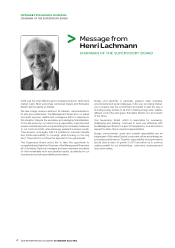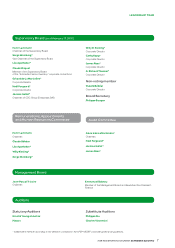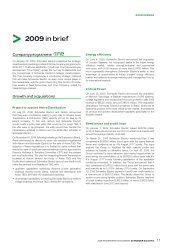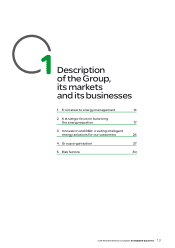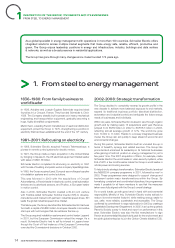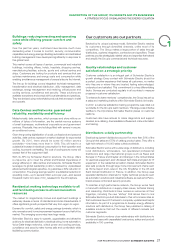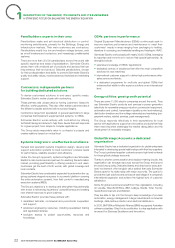APC 2009 Annual Report Download - page 16
Download and view the complete annual report
Please find page 16 of the 2009 APC annual report below. You can navigate through the pages in the report by either clicking on the pages listed below, or by using the keyword search tool below to find specific information within the annual report.
2009 REGISTRATION DOCUMENT SCHNEIDER ELECTRIC14
DESCRIPTION OFTHEGROUP, ITSMARKETS ANDITSBUSINESSES
1FROM STEEL TO ENERGY MANAGEMENT
As a global specialist in energy management with operations in more than 100 countries, Schneider Electric offers
integrated solutions across multiple market segments that make energy safe , reliable, effi cient, productive and
green. The Group enjoys leadership positions in energy and infrastructure, industry, buildings and data centres
&networks , as well as a broad presence in residential applications.
The Group has gone through many changes since it was founded 174 years ago.
>
1. From steel to energy management
1836–1980: From family business to
world leader
In 1836, Adolphe and Joseph-Eugène Schneider acquired steel
foundries in Le Creusot, France. They founded Schneider & Cie in
1838. The Company steadily built a presence in heavy mechanical
engineering and transportation equipment, gradually becoming a
huge, highly diversifi ed conglomerate.
Merlin Gerin, a leading French manufacturer of electrical distribution
equipment, joined the Group in 1975, strengthening a position in
electricity that had been established at the end of the 19thcentury.
1981–2001: Refocusing on electricity
In 1988, Schneider Electric acquired France’s Telemecanique, a
pioneer in remote control systems for electric motors.
In 1991, the Group made a major acquisition in the United States
by bringing in Square D, the US electrical equipment market leader
with sales of USD 1.65billion.
Schneider Electric completed its refocusing on electricity in 1997
with the sale of building and public works company Spie Batignolles.
In 1999, the Group acquired Lexel, Europe’s second largest supplier
of installation systems and control solutions.
This was followed in 2000 with the acquisitions of Crouzet
Automatismes, a French leader in electronic control, small automation
devices and customised sensors, and Positec, a European leader
in motion control.
Also in 2000, Schneider Electric created a 60-40 joint venture
with Toshiba called Schneider Toshiba Inverter (STI) to develop,
manufacture and market both partners’ industrial speed drives. STI
leads the global industrial speed drive market.
That same year, the Group launched the Schneider Electric Ventures
fund with a capital of EUR 50million to acquire interests in innovative
start-ups with technologies that can enhance the line up.
The Group acquired installation systems and control leader Legrand
in 2001, but the European Commission vetoed the merger. As a
result, Schneider Electric had to sell its interest in Legrand even
though the Court of First Instance of the European Communities
overruled the Commission’s decisions in October2002.
2002-2008: Strategic transformation
The Group decided to completely revamp its growth profi le in the
new decade to achieve more balanced exposure to end markets,
expand its traditional business portfolio (electrical distribution,
automation and industrial control) and anticipate the future energy
needs of businesses and individuals.
Within six years, Schneider Electric doubled in size through organic
growth and by making nearly 15 acquisitions each year. Revenue
jumped from EUR 9 billion in 2002 to EUR 18.3billion in 2008,
reflecting annual average growth of 12%. The workforce grew
from 70,000 to 114,000. Thanks to a loosely integrated business
model, the Group can act quickly to keep ahead of economic and
environmental changes.
During this period, Schneider Electric built an unrivaled line up in
terms of breadth, synergy and related services. The Group has
promoted and enhanced its leadership in its historical businesses
while gaining a forefront position in energy management in just a
few years’ time. The 2007 acquisition of Pelco, for example, made
Schneider Electric the world leader in video security systems, while
that of APC a few months earlier made the Group a world leader in
critical power and cooling services.
To help drive its strategic transformation, Schneider Electric launched
the NEW2004 company programme in 2001, followed by new2 in
2005. These programmes were designed to support change and
implement certain major transformations within the Group. By
formalizing consistent and coordinated objectives, the programmes
made it possible for all team members to see that the measures
taken were fully aligned with the Group’s overall strategy.
For a world leader, growth goes hand in hand with environmental
responsibility. Mindful of this, Schneider Electric works actively to
reduce its environmental footprint, while making energy easier to
use, safer, more reliable, sustainable and accessible. The Group
confi rmed its commitment to responsible action in 2002 by creating a
Sustainable Development Department. In 2005, it set up the quarterly
Planet & Society survey to track and report on performance in this
area. Schneider Electric was also the fi rst manufacturer to sign
French environmentalist Nicolas Hulot’s pact for the environment and
the sixth global enterprise to join the Clinton Climate Initiative (CCI).


